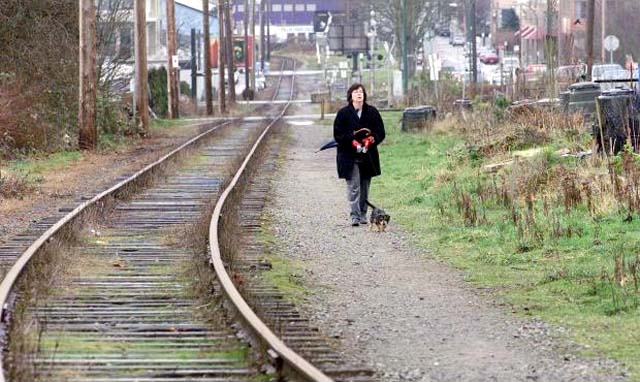|
A woman walks her dog along the Arbutus corridor near 6th Avenue - Date unknown Ian Smith.
3 June 2014
City and CPR Need to Get on Same Side of Arbutus Corridor Tracks
Vancouver British Columbia - The Canadian Pacific Railway sent a letter in early May to residents living along the Arbutus corridor
railway line to inform them the company was surveying the line and reconsidering railway operations.
The letter noted the CPR has been involved in conversation about the future use of the land, but the company and other parties have been unable to achieve a
plan for the disposition of this valuable asset.
The other parties were not named in the letter, but the CPR was referring to the City of Vancouver.
Vancouver's city council responded 20 May 2014 unanimously passing a resolution to confirm its opposition to freight trains in the corridor and the city's wish
to maintain the linear strip as a greenway for public use, until a light-rail transit line can be implemented.
The city and the CPR have been in conflict about the Arbutus corridor since at least the early 1980s, when the company began to consider other uses for the
land and the city eyed the strip as an option for public transit.
Negotiations went nowhere, and in 2000, Vancouver passed the Arbutus Corridor Official Development Plan bylaw to pre-empt its re-development.
The plan reserved the corridor as a greenway or for transportation, including rail, transit, or cycling, but not for motor vehicles or for elevated
transit.
The CPR sued the city, claiming, among other things, that although the railway retained title to the Arbutus corridor, the regulation of its property interest
was so onerous the city had effectively taken its interest and, therefore, the city ought to compensate the company.
The Supreme Court of Canada (SCOC) disagreed.
The court ruled unanimously in 2006 that the development bylaw fell within the city's powers to regulate land use and that it did not amount to a regulatory or
constructive taking.
In doing so, the SCOC articulated a two-part test for determining when regulation might amount to a taking of a property interest.
First, the regulating body had to acquire an interest in the property and, second, the regulation must remove all reasonable uses the private owner might make
of its interest.
The SCOC found the city had neither acquired an interest nor prevented all reasonable uses.
The company could continue to use the land as it had done for the past century as a railway line.
The bylaw stood.
The city did not need to compensate the CPR.
Since then, the corridor has become an informal greenway, although the public users of it are, as Justice Mary Southin remarked in the B.C. Court of Appeal,
trespassers all.
The land belongs to the CPR.
It is hard to imagine freight rail is any more viable now than it was when the CPR stopped running trains in 2001.
The company's recent surveying and brush clearing appear to be an effort to prompt negotiations with the city.
Council's currently expressed wish is that the corridor remain a greenway until such time as light rail can be built.
However, the development bylaw it passed in 2000, and the SCOC upheld, permits freight rail.
I do not think the CPR should be expected to give away its interest in the corridor, but the city should have wide latitude in regulating this and other
property interests.
I also think the SCOC struck an appropriate balance between protecting private interests and enabling municipalities to regulate them.
If the city were to go one step further and remove rail from the short list of permitted uses of the corridor, then the balance would be lost.
Moreover, such a move would likely amount to a regulatory or constructive taking of property under the SCOC's test.
The city would effectively acquire a greenway and the CPR would have no reasonable use of its property.
As much as I love what appears as an abandoned rail line through the city of Vancouver, I recognize that another, and almost certainly more intensive use of
the land is inevitable.
Some mix of uses, including greenway, public transit, and residential and commercial development, perhaps along the lines proposed by a panel of architects and
planners in 2007, would be a desirable outcome.
This or something similar is more likely to be achieved if the city and company talk about their respective interests rather than firing salvos from their
respective sides of the tracks.
Douglas Harris.
   |

